This post has been updated for 2021
As opposed to pink, blue, and yellow diamonds that have been dominating auction blocks for the past 40 years, green diamonds have made relatively few appearances. While lack of supply is the main contributing factor, other factors such as “underestimation” may be at fault as well. In a two-part series, we'll share insight regarding some of history's most beautiful and significant natural green diamonds.
More specifically, part 1 will be covering:
- How do green diamonds get their color?
- How do color modifiers affect green diamond value?
- What should you know about green diamonds as an investor?
- Where do green diamonds come from?
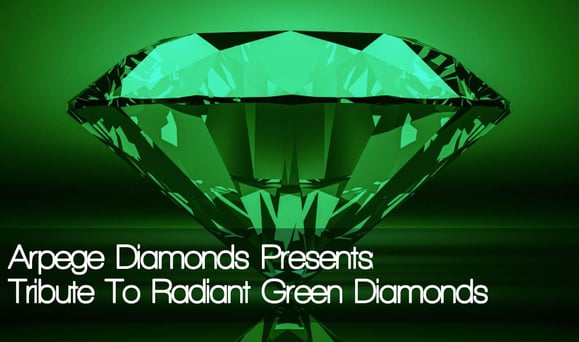
How do Green Diamonds Get Their Color?
Colored diamonds owe their magnificent colors to either lattice defects or chemical impurities. Green diamonds however, are truly unique as their hue is caused by something completely different.
The radiant color of these natural green diamonds is caused by exposure to radiation during the diamond's formation and journey towards the Earth’s surface. It should be noted that only the portions of the diamond that came into direct contact will illustrate a green hue. This results in stones with different shading or completely uneven coloration. This further contributes to their rarity as a diamond with a completely uniform hue, as it is extremely hard to find.
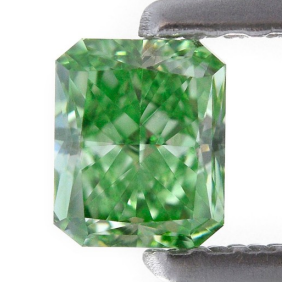
The color intensity and uniformity of these beautiful diamonds is determined by three main factors:
- The level of radiation the diamond had been subjected to.
- The duration of the exposure.
- The mass of the diamond.
The most commonly found green diamonds are "skin stones." This essentially means that only the surface of the diamond contains a green hue as result of exposure to weaker levels of radiation (Alpha.) Often, such stones lose the intensity of their hue as they are cut and polished, and sometimes they may even lose their color completely.
On the other hand, stronger levels of radiation (such as Beta and Gamma) tend to permeate deeper into the diamond’s body, resulting in green diamonds with a much richer color and uniformity. These are the types of green diamonds that are sought after by investors. It should be noted that due to their lack of supply and extreme rarity (Beta and Gamma irradiated stones constitute only 0.1% of all green diamonds found), the value of such diamonds could be astronomical rivaling that of the great reds, blues, and pinks.

As is the case with all colored diamonds, green diamonds are in part assessed based on the intensity of their hue ranging from light green and fancy light green, to fancy deep green and fancy vivid green. Moreover secondary color modifiers of green diamonds include yellow, brown, gray, and in rare instances even blue.
How Do Secondary Color Modifiers Affect Green Diamond Value?
As investors and diamond enthusiasts, you already know that the most rare and highly valued fancy colored diamonds are those that exhibit only one color at its purest form, without any modifiers. Further, as the intensity of a diamond’s color saturation increases, so will its value.

While that is also the case for green and fancy green gems, there is one very large exception. When the green diamonds have additional hues of comparably rare colors, their rarity and value can equal, and even exceed, that of a monochromatic pure green diamond.
For example, a “fancy blue-green” of considerable saturation, such as the “Ocean Dream” will command a significantly higher price due to the immense rarity of this color combination.
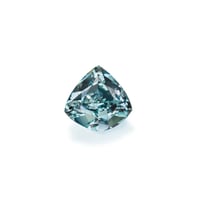
What Should You Know About Green Diamonds As An Investor?
Even with today’s technological advancements, gemologists are still finding it challenging to differentiate between naturally green diamonds from treated ones. The irradiation process that takes part in nature can be almost perfectly emulated in a laboratory, ultimately creating artificially green diamonds that are practically indistinguishable from their natural counterparts.
As you may have already guessed, while naturally and artificially colored green diamonds may seem to be identical, their marketplace value is immensely different. This is wholly due to the immense rarity these diamonds hold, especially in the case of diamonds exposed to larger levels of radiation such as Beta and Gamma (mentioned above).
It is therefore very important to ensure that the diamond you are considering for purchase has been submitted to the GIA, and comes with an “origin of color” identification report to ensure its authenticity and quality. Further, despite the lack of definitive tests, GIA gemologists rely on certain elements to evaluate and differentiate treated versus naturally green diamonds.
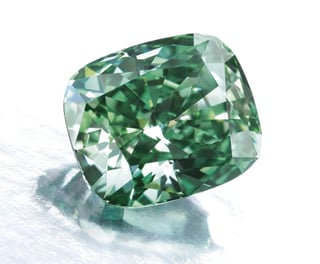
Natural green diamonds often display radiation stains in the form of green or brown spots, which cannot be duplicated in a laboratory. These natural radiation stains are on the surface, and in the case of skin stones, are often removed as the diamond goes through faceting processes. As mentioned above, this will ultimately cause such gems to lose most, if not all, of their color after being cut and polished into their final form. To counter this, in some instances, few such stains are left along the girdle area in order to preserve the diamond’s color.
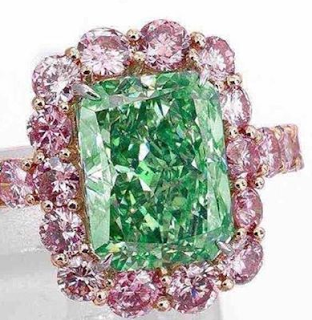
Another important factor to look out for is color uniformity. Treated green diamonds are generally homogenous throughout their body, and although it is possible to find a naturally green or bluish-green diamond yielding close to perfect color uniformity, it is very rare. It should be noted however, that sometimes the artificial green color is created slightly beneath the stone’s surface causing it to display very discrete zoning patterns along facet arrangements not present in naturally green diamonds.
For more information on investing in green diamonds, check out our article below, where we answer the question "are green diamonds worth investing or collecting?"
Where Do Green Diamonds Come From?
Only a few instances of green diamonds have been documented to occur naturally in history, but several trace back to South America, in countries such as Venezuela, Brazil, and Guyana. There have also been cases of such diamonds originating from mines in Africa.
For more reading on colored diamonds, check out the link below. Make sure to check back when we look into the history of 4 of our favorite green diamonds of all time.


